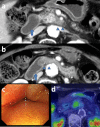Conversion surgery for initially unresectable locally advanced pancreatic ductal adenocarcinoma after chemotherapy followed by carbon-ion radiotherapy: a case report
- PMID: 38200536
- PMCID: PMC10782725
- DOI: 10.1186/s13256-023-04311-3
Conversion surgery for initially unresectable locally advanced pancreatic ductal adenocarcinoma after chemotherapy followed by carbon-ion radiotherapy: a case report
Abstract
Background: Recent advances in chemotherapy and chemoradiotherapy have enabled conversion surgery (CS) to be performed for selected patients with initially unresectable locally advanced (LA) pancreatic ductal adenocarcinoma (PDAC). Many studies indicate CS might extend the survival of patients with initially unresectable LA PDAC. However, several clinical questions concerning CS remain, such as the optimal preoperative treatment. Carbon-ion radiotherapy (CIRT) is a unique radiotherapy that offers higher biological effectiveness than conventional radiotherapy. Here, we report a long-term survival case with initially unresectable LA PDAC who underwent CS after chemotherapy followed by CIRT.
Case presentation: The patient was a 72-year-old Japanese woman with unresectable LA pancreatic head cancer with tumor contact to the superior mesenteric artery (SMA). She underwent four courses of chemotherapy (gemcitabine plus nanoparticle albumin-bound paclitaxel). However, the lesion did not shrink and tumor contact with the SMA did not improve after chemotherapy. Because the probability of achieving curative resection was judged to be low, she underwent radical dose CIRT, and chemotherapy was continued. She complained of vomiting 2 months after CIRT. Although imaging studies showed no tumor growth or metastasis, a duodenal obstruction which was speculated to be an adverse effect of CIRT was observed. She could not eat solid food and a trans-nasal feeding tube was inserted. Therapeutic intervention was required to enable enteral nutrition. We proposed several treatment options. She chose resection with the expectation of an anti-tumor effect of chemotherapy and CIRT rather than course observation with tube feeding or bypass surgery. Therefore, subtotal-stomach-preserving pancreatoduodenectomy with portal vein resection was performed as CS. Pathological examination of the resected specimen revealed an R0 resection with a histological response of Evans grade IIA. Postoperatively, she recovered uneventfully. Adjuvant chemotherapy with tegafur/gimeracil/oteracil (S1) was administrated. At the time of this report, 5 years have passed since the initial consultation and she has experienced no tumor recurrence.
Conclusions: The present case suggests that multidisciplinary treatment consisting of a combination of recent chemotherapy and CIRT may be beneficial for unresectable LA PDAC. However, further studies are required to assess the true efficacy of this treatment strategy.
Keywords: Carbon-ion radiotherapy; Conversion surgery; Pancreatic ductal adenocarcinoma.
© 2024. The Author(s).
Conflict of interest statement
The authors declare that they have no competing interests related to this manuscript.
Figures






Similar articles
-
Conversion surgery for an initially unresectable, locally advanced pancreatic cancer after induction chemotherapy and carbon-ion radiotherapy: a case report.Surg Case Rep. 2018 Sep 10;4(1):112. doi: 10.1186/s40792-018-0522-4. Surg Case Rep. 2018. PMID: 30203372 Free PMC article.
-
[Treatment Experience of Chemotherapy and Carbon-Ion Radiotherapy followed by Curative Conversion Surgery for Initially Locally Advanced Unresectable Pancreatic Cancer after Distal Gastrectomy].Gan To Kagaku Ryoho. 2023 Dec;50(13):1959-1961. Gan To Kagaku Ryoho. 2023. PMID: 38303264 Japanese.
-
Conversion surgery with gemcitabine plus nab-paclitaxel for locally advanced unresectable pancreatic cancer: A case report.Mol Clin Oncol. 2018 Oct;9(4):389-393. doi: 10.3892/mco.2018.1688. Epub 2018 Aug 1. Mol Clin Oncol. 2018. PMID: 30214727 Free PMC article.
-
Palliative Chemotherapy: Does It Only Provide False Hope? The Role of Palliative Care in a Young Patient With Newly Diagnosed Metastatic Adenocarcinoma.J Adv Pract Oncol. 2017 May-Jun;8(4):382-386. Epub 2017 May 1. J Adv Pract Oncol. 2017. PMID: 30018843 Free PMC article. Review.
-
Surgical indication for and desirable outcomes of conversion surgery in patients with initially unresectable pancreatic ductal adenocarcinoma.Ann Gastroenterol Surg. 2019 Oct 29;4(1):6-13. doi: 10.1002/ags3.12295. eCollection 2020 Jan. Ann Gastroenterol Surg. 2019. PMID: 32021953 Free PMC article. Review.
Cited by
-
Borderline Resectable Pancreatic Cancer: Neoadjuvant Chemotherapy, Stereotactic Body Radiotherapy (SBRT), and Surgery.Cureus. 2025 May 8;17(5):e83706. doi: 10.7759/cureus.83706. eCollection 2025 May. Cureus. 2025. PMID: 40486350 Free PMC article.
References
-
- Satoi S, Yamaue H, Kato K, et al. Role of adjuvant surgery for patients with initially unresectable pancreatic cancer with a long-term favorable responses to non-surgical anti-cancer treatments: results of a project study for pancreatic surgery by the Japanese Society of Hepato-Biliary-Pancreatic Surgery. J Hepatobiliary Pancreat Sci. 2013;20:590–600. doi: 10.1007/s00534-013-0616-0. - DOI - PubMed
Publication types
MeSH terms
Substances
LinkOut - more resources
Full Text Sources
Medical

